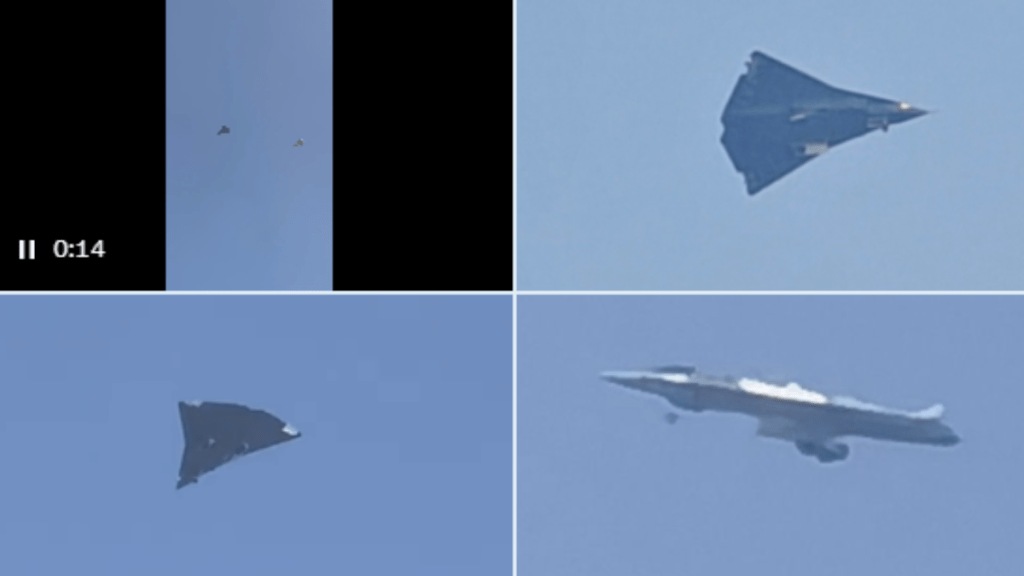Even as India continues to work on its fifth-generation Advanced Medium Combat Aircraft (AMCA), China has made headlines with the flight of its sixth-generation fighter jet. This stark contrast in development timelines has raised serious concerns about India’s position in the global defence race. There are images on the X (formerly Twitter) depicting the Chinese sixth generation fighter jet flying.
While India remains involved in the process of developing its AMCA, China has already moved ahead with a sixth-generation fighter, proving that India is lagging behind in the race for air superiority.
China’s Leap to the Sixth Generation
In November 2024, China unveiled its sixth-generation fighter, the AVIC Baidi Type-B, at the Zhuhai Airshow, with footage soon emerging of the fighter in flight. This aircraft is being touted as a significant leap forward, with features such as a tailless design and diamond-shaped wings, resembling some renderings from the US and Western models. Though many of the fighter’s capabilities are still under wraps, speculation points to its enhanced stealth features and potential for operations in space, though the latter remains sceptical.
China’s rapid progress underscores the country’s growing technological prowess in defence. The Baidi Type-B is just the latest in a string of advancements, following the 2011 debut and 2017 induction of its fifth-generation Chengdu J-20 Mighty Dragon.
In comparison, the United States’ F-22 Raptor, the world’s first fifth-generation fighter, took over a decade to reach full operational status. While China’s stealth capabilities, particularly with the J-20, have drawn some criticism, the leap to the sixth-generation fighter is a clear indication that the country is committed to staying ahead of the curve.
India’s Struggles with AMCA Development
Meanwhile, India is still in the early stages of developing its own fifth-generation fighter, the AMCA. Despite receiving approval from the Cabinet Committee on Security (CCS), the AMCA is far from reality. The program, led by the Aeronautical Development Agency (ADA) in collaboration with Hindustan Aeronautics Limited (HAL), has been beset by delays. The first flight of the AMCA is now expected in 2026, with the aircraft likely entering service around the early 2030s, but these timelines remain uncertain.
The AMCA has been seen as India’s solution to its aging fleet and to counter increasingly advanced adversaries like China. However, progress has been slow, and technical challenges, particularly with the engine, remain a major hurdle. The AMCA is expected to use the GE-414 engine, which will be shared with the Tejas Mk2 fighter, but the final engine choice for the production version could be different, further complicating timelines.
Moreover, India’s defence budget has struggled to meet the demand for cutting-edge technology, as the country is still heavily reliant on older platforms like the Su-30MKI and MiG-29, while simultaneously trying to acquire newer platforms like the French Rafale. The lack of a steady and reliable fighter production pipeline has left India vulnerable to delays in key defence programs.
The Growing Gap: India’s Strategic Vulnerability
As China progresses with its sixth-generation fighter program, India finds itself in a precarious position. While the AMCA is still in the prototype stage and unlikely to see induction until the next decade, China is already preparing to deploy a fighter jet that promises to be far more advanced, equipped with technologies that will likely surpass anything in India’s current arsenal.
This situation highlights a significant strategic vulnerability. India, which shares a tense border with China, needs to address this growing gap in military capabilities urgently. The future of air combat is already taking shape, with nations like China and the United States looking toward sixth-generation fighters that will redefine the nature of aerial warfare. By the time the AMCA enters service, it may already be outdated in comparison to the capabilities of China’s sixth-gen fighter, leaving India at a severe disadvantage in the event of conflict.
The Need for Accelerated Development
The long timelines and technical delays of the AMCA program, while understandable given the scale of such an ambitious project, cannot be ignored. “India cannot afford to wait for decades to catch up with China, especially when the regional security environment is becoming increasingly volatile,” opined a former IAF officer.
According to the officer who wished to remain anonymous, “One solution could be to speed up the AMCA’s development, possibly by outsourcing some of the technology or by partnering with foreign nations that already possess the necessary expertise in building advanced fighter jets. Collaborations with countries like the United States, Russia, or even European nations could provide valuable access to technology that would significantly shorten development timelines. India must also consider the possibility of bolstering its fleet with additional Rafales or other modern platforms to bridge the gap until the AMCA becomes operational.”
Moreover, “the Indian Air Force (IAF) could look into acquiring other advanced systems, such as unmanned aerial vehicles (UAVs) and drones, to complement its manned fighter fleet and provide a more balanced defence capability in the future. The integration of such systems into India’s air force could provide a competitive edge, even in the absence of sixth-generation fighters,” he stated.

